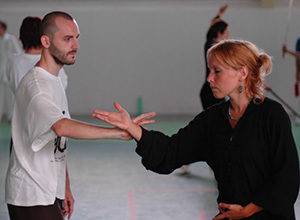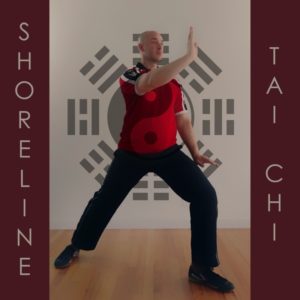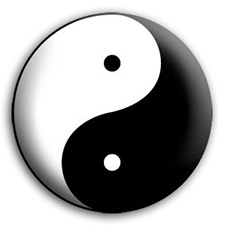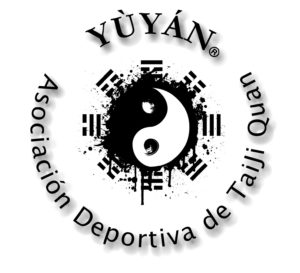Slanted FlyingJournal of Tai Chi Chuan
Philosophy
Taking The Initiative In Taijiquan
As long as we do not over-commit to our attack, and we maintain our changeability, our initiation of the interaction should be able to follow Taijiquan strategy. We can maintain our relaxed sensitivity and our ability to understand our opponent. The quality of the contact should not be crashing in (or banging against, etc.) unless they fail to properly defend, but should instead be able to match the energy of the opponent when they make defensive contact.
We want the potential, on contact, to either absorb or project, pull or push, expand or contract, to be able to express energy in any direction, and when we listen to and understand what is happening at the point of contact, then we will be able to act appropriately, regardless of which direction or which energy is called for. This should remain true even when we initiate the contact.
 Yaxuan (李雅轩) wrote (as translated by Scott Meredith): “Even before physical contact, with a single glance you join contact with the opponent or partner, establishing a firm connection with him. Adherence can begin even at this stage, prior to physical contact. This is important because when you are working in a more intensive competitive or combative mode, if you depend on physical contact to start your adherence, that’s too late and you’re going to be too slow to exploit any advantage of timing or positioning.”
Yaxuan (李雅轩) wrote (as translated by Scott Meredith): “Even before physical contact, with a single glance you join contact with the opponent or partner, establishing a firm connection with him. Adherence can begin even at this stage, prior to physical contact. This is important because when you are working in a more intensive competitive or combative mode, if you depend on physical contact to start your adherence, that’s too late and you’re going to be too slow to exploit any advantage of timing or positioning.”
This indicates that we should already engage with our opponent prior to touching them. We should understand their posture, distance, movements, intent, etc, even prior to contact. We can already follow their movements, attempting to control the distance, and seeking advantageous angles. In a sense this is “stick and adhere, connect and follow” even without contact.
we already have “stick and adhere, connect and follow” prior to contact, then the idea behind initiating an attack from non-contact is similar to counter-attacking from contact. However, a strength of Taijiquan is using skills typically acquired through from-contact push-hands training. We should be able to understand our opponent’s intent better when in contact with them, rather than relying mainly on sight.
Yang Chengfu (楊澄甫) expressed an approach to dealing with fast attacks from opponents in his 1931 book (as translated by Paul Brennan): “If the opponent attacks slowly, then soften, neutralize, and follow him. This principle makes sense to you all. But if he attacks very fast, what good would softening and neutralizing be? Thus I apply Taiji’s intercepting energy and the principle of “neither after nor before” as a response. What is the intercepting energy? It is like a hiding army suddenly coming out to strike. What does neither after nor before mean? If his hand is on its way but not yet arrived, my hand intercepts his arm before it has straightened, promptly dispelling his attack. This is defeating a frontal assault by way of a frontal assault. ‘If he moves fast, I quickly respond.’”
Although intercepting is not initiating the attack (it is attacking the opponent’s attack), it can be used from non-contact. This would be one strategy for dealing with a boxing jab. By intercepting the jabbing arm before the fist arrives, their attack is dispelled. With training, intercepting can be used not only to disrupt the opponent’s attack, but can also affect their structure and capture their balance. While intercepting is not a primary Taijiquan strategy, it is not uncommon, especially in weapons sparring where fast interactions are frequently initiated from non-contact.
Using weapons for sparring in Taijiquan often involves breaking contact from the opponent. While many weapons train to have a “sticky” quality while controlling the opponent’s weapon, the subsequent attacks are often done by breaking contact (preventing the opponent from being able to use the contact in their defense). Taking the initiative in weapons sparring is not incompatible with empty hand principles concerning taking the initiative.
Yang Chengfu also wrote (Brennan translation): “If the opponent jumps away and is too wary to come back right away, I switch to a different posture from the solo set and wait for him. I should not pursue his retreat but instead be like a tiger waiting for its chance to pounce on a deer. While he walks at circle’s edge, I am at the center. I hold to steadiness while he holds to restlessness. When his restlessness increases until he wears himself out, I attack him with full stability. He has thus generated the means for me to overcome him, and he now presents no difficulty and I enter through his guard. This is the Grand Polarity [tai ji] generating its two polarities which exponentiate into the four manifestations and the eight trigrams while itself remaining stable and immovable.”
This gives another approach to dealing with an opponent who is beyond contact range. It is unclear what he means by “I attack him with full stability,” but here he does not mention the opponent attacking first (“be like a tiger waiting for its chance to pounce on a deer”), rather the opponent appears to “wear himself out” while outside of contact range which then allows an attack initiated by the Taijiquan practitioner. I interpret “full stability” to mean being centered and capable of using any of Taijiquan’s thirteen postures/energies (十三式 shi san shi).
Finally, Chen Weiming (陳微明) (Brennan translation) pointed out in his 1929 book that the ability to take the initiative may also depend on the relative skill levels of the participants:
“The extent to which I go along with the opponent depends on the degree of my skill:
– If I have a lesser skill, then I must go along with him longer, and I must wait until his power has finished in order to be able to counter.
– If I have a somewhat greater skill, then I can go along with him to a shorter extent, waiting until his power has come out halfway and interrupting it, and then right away I can counter.
– If I have a much greater skill, then I go along with him the tiniest little bit, interrupting his power from the start, and then right away I can counter. Sometimes when I am sticking to him, his power is completely unable to issue and I can instantly release energy, in which case I do need to go along with him, for I am in charge.”













